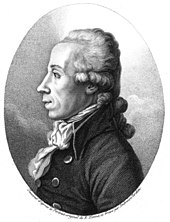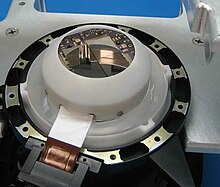Tellurium
[10] Tellurium-bearing compounds were first discovered in 1782 in a gold mine in Kleinschlatten, Transylvania (now Zlatna, Romania) by Austrian mineralogist Franz-Joseph Müller von Reichenstein, although it was Martin Heinrich Klaproth who named the new element in 1798 after the Latin tellus 'earth'.
The rarity of tellurium on Earth is thought to be caused by conditions during preaccretional sorting in the solar nebula, when the stable form of certain elements, in the absence of oxygen and water, was controlled by the reductive power of free hydrogen.
In contrast to selenium, tellurium does not usually replace sulfur in minerals because of the great difference in ion radii.
This ore was known as "Faczebajer weißes blättriges Golderz" (white leafy gold ore from Faczebaja, German name of Facebánya, now Fața Băii in Alba County) or antimonalischer Goldkies (antimonic gold pyrite), and according to Anton von Rupprecht, was Spießglaskönig (argent molybdique), containing native antimony.
[28] In 1782 Franz-Joseph Müller von Reichenstein, who was then serving as the Austrian chief inspector of mines in Transylvania, concluded that the ore did not contain antimony but was bismuth sulfide.
After a thorough investigation that lasted three years and included more than fifty tests, Müller determined the specific gravity of the mineral and noted that when heated, the new metal gives off a white smoke with a radish-like odor; that it imparts a red color to sulfuric acid; and that when this solution is diluted with water, it has a black precipitate.
[30][31][32] In 1789, a Hungarian scientist, Pál Kitaibel, discovered the element independently in an ore from Deutsch-Pilsen that had been regarded as argentiferous molybdenite, but later he gave the credit to Müller.
[33][31][32][34] In the early 1920s, Thomas Midgley Jr. found tellurium prevented engine knocking when added to fuel, but ruled it out due to the difficult-to-eradicate smell.
[35] The 1960s brought an increase in thermoelectric applications for tellurium (as bismuth telluride), and in free-machining steel alloys, which became the dominant use.
[37] The anode sludges contain the selenides and tellurides of the noble metals in compounds with the formula M2Se or M2Te (M = Cu, Ag, Au).
In recent years, the tellurium price was driven up by increased demand and limited supply, reaching as high as US$220 per pound in 2006.
In 2022, the largest Te providers by volume were China (340 tonnes), Russia (80 t), Japan (70 t), Canada (50 t), Uzbekistan (50 t), Sweden (40 t) and the United States (no official data).
[43] Decomposition of ZnTe with hydrochloric acid yields hydrogen telluride (H2Te), a highly unstable analogue of the other chalcogen hydrides, H2O, H2S and H2Se:[44] The +2 oxidation state is exhibited by the dihalides, TeCl2, TeBr2 and TeI2.
The dihalides have not been obtained in pure form,[45]: 274 although they are known decomposition products of the tetrahalides in organic solvents, and the derived tetrahalotellurates are well-characterized: where X is Cl, Br, or I.
[38] Tellurium does not readily form analogues of alcohols and thiols, with the functional group –TeH, that are called tellurols.
[55] Recently, physicists and materials scientists have been discovering unusual quantum properties associated with layered compounds composed of tellurium that's combined with certain rare-earth elements, as well as yttrium (Y).
[56] These novel materials have the general formula of R Te3, where "R " represents a rare-earth lanthanide (or Y), with the full family consisting of R = Y, lanthanum (La), cerium (Ce), praseodymium (Pr), neodymium (Nd), samarium (Sm), gadolinium (Gd), terbium (Tb), dysprosium (Dy), holmium (Ho), erbium (Er), and thulium (Tm).
These materials have a two-dimensional character within an orthorhombic crystal structure, with slabs of R Te separated by sheets of pure tellurium.
[56] It is thought that this 2-D layered structure is what leads to a number of interesting quantum features, such as charge-density waves, high carrier mobility, superconductivity under specific conditions, and other peculiar properties whose natures are only now emerging.
[56] For example, in 2022, a small group of physicists at Boston College in Massachusetts led an international team that used optical methods to demonstrate a novel axial mode of a Higgs-like particle in R Te3 compounds that incorporate either of two rare-earth elements (R = La, Gd).
[11] In June 2022, China set goals of generating 25% of energy consumption and installing 1.2 billion kilowatts of capacity for wind and solar power by 2030.
[11] Tellurium shows up in a number of photocathodes used in solar blind photomultiplier tubes[75] and for high brightness photoinjectors driving modern particle accelerators.
More Te containing photocathodes have been grown using other alkali metals such as rubidium, Potassium, and Sodium, but they have not found the same popularity that Cs-Te has enjoyed.
A trigonal Te with the space group of P3121 can transfer into a topological insulator phase, which is suitable for thermoelectric material.
The BiTe-based TE material can achieve a conversion efficiency of 8%, an average zT value of 1.05 for p-type and 0.84 for n-type bismuth telluride alloys.
[82] Tellurium has no known biological function, although fungi can incorporate it in place of sulfur and selenium into amino acids such as telluro-cysteine and telluro-methionine.
Many bacteria, such as Pseudomonas aeruginosa and Gayadomonas sp, take up tellurite and reduce it to elemental tellurium, which accumulates and causes a characteristic and often dramatic darkening of cells.
[24][94] This is caused by the body converting tellurium from any oxidation state to dimethyl telluride, (CH3)2Te, a volatile compound with a pungent garlic-like smell.
In laboratories, this odor makes it possible to discern which scientists are responsible for tellurium chemistry, and even which books they have handled in the past.
The National Institute for Occupational Safety and Health (NIOSH) has set the recommended exposure limit (REL) at 0.1 mg/m3 over an eight-hour workday.




4




